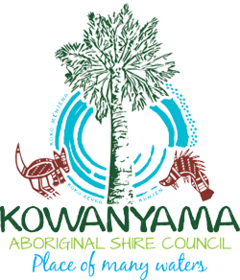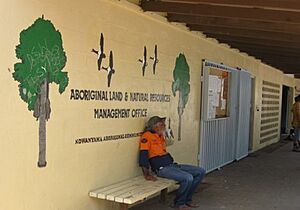Aboriginal Shire of Kowanyama facts for kids
Quick facts for kids Aboriginal Shire of KowanyamaQueensland |
|||||||||||||||
|---|---|---|---|---|---|---|---|---|---|---|---|---|---|---|---|

Location within Queensland
|
|||||||||||||||
| Population | 1,079 (2021 census) | ||||||||||||||
| • Density | 0.42231/km2 (1.0938/sq mi) | ||||||||||||||
| Established | 1987 | ||||||||||||||
| Area | 2,555 km2 (986.5 sq mi) | ||||||||||||||
| Mayor | Robert Michael Sands | ||||||||||||||
| Council seat | Kowanyama | ||||||||||||||
| Region | Cape York | ||||||||||||||
| State electorate(s) | Cook | ||||||||||||||
| Federal Division(s) | Leichhardt | ||||||||||||||
 |
|||||||||||||||
| Website | Aboriginal Shire of Kowanyama | ||||||||||||||
|
|||||||||||||||
The Aboriginal Shire of Kowanyama is a special local government area in Queensland, Australia. It is found on the western side of the Cape York Peninsula. This area is managed under a special agreement called a Deed of Grant in Trust.
In 2021, the Aboriginal Shire of Kowanyama had a population of 1,079 people.
Contents
Discovering Kowanyama's Past
The Kowanyama area started as the Mitchell River Mission in 1916. Over time, Aboriginal people from nearby areas moved to this mission settlement. Many different language groups are connected to the Kowanyama region. These include Yir-Yoront, Yirrk Thangalkl, Koko Bera, and Kunjen.
The Kunjen language is also known as Koko Wanggara, Ngundjan, and Olkola. Its traditional area is in Western Cape York. This includes land within the Kowanyama Community Council and Cook Shire Council areas.
The Yir Yiront language is another Australian Aboriginal language. Its traditional home is also in Western Cape York. This covers parts of the Aboriginal Shire of Kowanyama and Shire of Cook. It includes the areas around the Coleman River and Mitchell River. Today, it is also spoken in Pormpuraaw and Kowanyama.
In 1967, the Anglican Church could no longer run the mission. A government department then took over managing the community.
On 23 July 1987, the Kowanyama community received a special land grant. This was called a Deed of Grant in Trust. Like other communities with this grant, Kowanyama got its own town Council. This Council was elected by Aboriginal people living in the community. The Council's job was to manage the land and community affairs. Seven elected Aboriginal residents serve on the Council for three years.
Kowanyama's Population
In 2016, the Aboriginal Shire of Kowanyama had 944 people. By 2021, the population grew to 1,079 people.
What the Council Does
The Kowanyama Shire Council works under the Local Government Act 2009. This means its jobs are similar to other local councils in remote Queensland. The Council helps manage things like fishing rules and local businesses.
Community Justice and Elders
Kowanyama has a Community Justice Group. This group is made up of respected people from the community. They meet to talk about local issues and give advice to the Council.
The community also has a Council of Elders. The Kowanyama Council asks the Elders for advice when making important decisions. The Elders work closely with the Lands Office.
The Lands Office: Protecting Land and Culture
The Kowanyama Aboriginal Land and Natural Resources Management Office (KALNRMO) helps Aboriginal people manage their land and cultural resources. They work with the community to plan for the Kowanyama region.
Their plans include:
- Helping develop homelands (traditional living areas).
- Managing land and fisheries (fishing areas).
- Handling tourism and visitors.
- Running the Kowanyama Ranger Service.
- Working on Native Title Claims (recognizing traditional land rights).
- Documenting Cultural Resources (important cultural sites and knowledge).
KALNRMO's work has made Kowanyama a leader in Indigenous land management. Since 1987, Kowanyama has gained control over fishing in the Mitchell River Delta. They have even closed some waters to non-Aboriginal fishing. This helps Aboriginal people access fish for their cultural and daily needs. This way, they can fish and hunt as their ancestors have for thousands of years.
KALNRMO also hires Indigenous rangers. These rangers help manage the land in many areas. They patrol fishing waters and make sure rules are followed. Since 2007, the rangers have also monitored turtle populations. They help remove old fishing nets from the Gulf of Carpentaria. These nets are often left behind by fishermen and can harm marine life.
Leaders of Kowanyama
- 2008–2012: Thomas Farlane Hudson
- 2012–2016: Robert Holness
- 2016–2020: Michael Yam
- 2020–present: Robert Michael Sands



